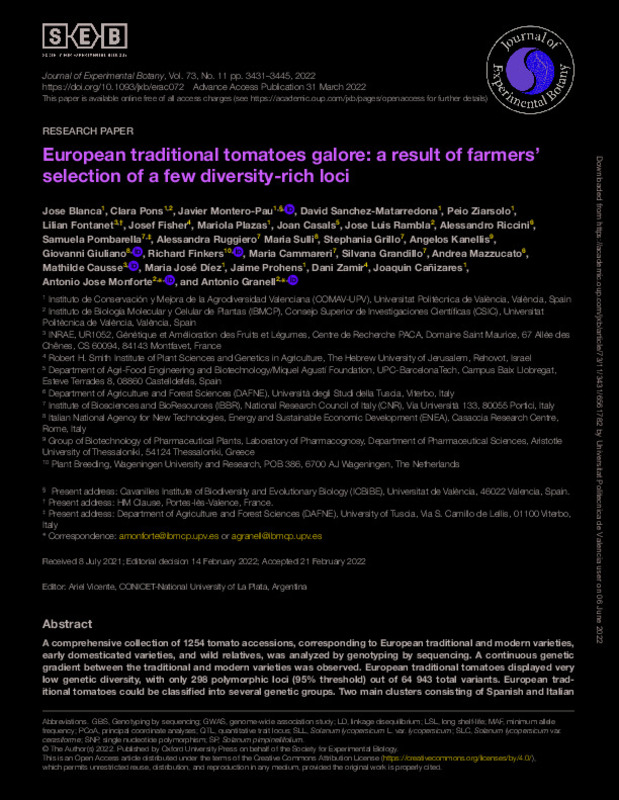Blanca Postigo, JM.; Pons Puig, C.; Montero-Pau, J.; Sánchez-Matarredona, D.; Ziarsolo, P.; Fontanet, L.; Fisher, J.... (2022). European traditional tomatoes galore: a result of farmers' selection of a few diversity-rich loci. Journal of Experimental Botany. 73(11):3431-3445. https://doi.org/10.1093/jxb/erac072
Por favor, use este identificador para citar o enlazar este ítem: http://hdl.handle.net/10251/203724
|
Título:
|
European traditional tomatoes galore: a result of farmers' selection of a few diversity-rich loci
|
|
Autor:
|

 Blanca Postigo, José Miguel
Blanca Postigo, José Miguel
 Pons Puig, Clara
Pons Puig, Clara
 Montero-Pau, Javier
Sánchez-Matarredona, David
Montero-Pau, Javier
Sánchez-Matarredona, David
 Ziarsolo, Peio
Fontanet, Lilian
Fisher, Josef
Ziarsolo, Peio
Fontanet, Lilian
Fisher, Josef

 Plazas Ávila, María de la O
Casals, Joan
Plazas Ávila, María de la O
Casals, Joan
 Rambla Nebot, Jose Luis
Riccini, Alessandro
Pombarella, Samuela
Ruggiero, Alessandra
Suli, Maria
Grillo, Stephania
Díez, Maria José
Rambla Nebot, Jose Luis
Riccini, Alessandro
Pombarella, Samuela
Ruggiero, Alessandra
Suli, Maria
Grillo, Stephania
Díez, Maria José

 Prohens Tomás, Jaime
Prohens Tomás, Jaime

 Cañizares Sales, Joaquín
Cañizares Sales, Joaquín

 Monforte Gilabert, Antonio José
Monforte Gilabert, Antonio José

 GRANELL RICHART, ANTONIO
GRANELL RICHART, ANTONIO
|
|
Entidad UPV:
|
Universitat Politècnica de València. Escuela Técnica Superior de Ingeniería Agronómica y del Medio Natural - Escola Tècnica Superior d'Enginyeria Agronòmica i del Medi Natural
|
|
Fecha difusión:
|
|
|
Resumen:
|
[EN] The high phenotypic diversity observed among European traditional tomato varieties was created by traditional farmer-driven selection by inadvertently combining a very few polymorphic loci subjected to balancing ...[+]
[EN] The high phenotypic diversity observed among European traditional tomato varieties was created by traditional farmer-driven selection by inadvertently combining a very few polymorphic loci subjected to balancing selection.
A comprehensive collection of 1254 tomato accessions, corresponding to European traditional and modern varieties, early domesticated varieties, and wild relatives, was analyzed by genotyping by sequencing. A continuous genetic gradient between the traditional and modern varieties was observed. European traditional tomatoes displayed very low genetic diversity, with only 298 polymorphic loci (95% threshold) out of 64 943 total variants. European traditional tomatoes could be classified into several genetic groups. Two main clusters consisting of Spanish and Italian accessions showed higher genetic diversity than the remaining varieties, suggesting that these regions might be independent secondary centers of diversity with a different history. Other varieties seem to be the result of a more recent complex pattern of migrations and hybridizations among the European regions. Several polymorphic loci were associated in a genome-wide association study with fruit morphological traits in the European traditional collection. The corresponding alleles were found to contribute to the distinctive phenotypic characteristic of the genetic varietal groups. The few highly polymorphic loci associated with morphological traits in an otherwise a low-diversity population suggests a history of balancing selection, in which tomato farmers likely maintained the morphological variation by inadvertently applying a high selective pressure within different varietal types.
[-]
|
|
Palabras clave:
|
Crop evolution
,
Diversification
,
Fruit morphology
,
Genome-wide association study
,
Genotyping by sequencing
,
Selection
,
Single nucleotide polymorphism
|
|
Derechos de uso:
|
Reconocimiento (by)
|
|
Fuente:
|
Journal of Experimental Botany. (issn:
0022-0957
)
|
|
DOI:
|
10.1093/jxb/erac072
|
|
Editorial:
|
Oxford University Press
|
|
Versión del editor:
|
https://doi.org/10.1093/jxb/erac072
|
|
Código del Proyecto:
|
info:eu-repo/grantAgreement/EC/H2020/101000716/EU
info:eu-repo/grantAgreement/EC/H2020/634561/EU
info:eu-repo/grantAgreement/EC/H2020/677379/EU
|
|
Agradecimientos:
|
This work was supported by the European Commission H2020 research and innovation program through TRADITOM grant agreement no. 634561, G2P-SOL, grant agreement no. 677379, and HARNESSTOM grant agreement no. 101000716. MP ...[+]
This work was supported by the European Commission H2020 research and innovation program through TRADITOM grant agreement no. 634561, G2P-SOL, grant agreement no. 677379, and HARNESSTOM grant agreement no. 101000716. MP is grateful to the Spanish Ministerio de Ciencia e Innovacion for a postdoctoral grant (IJC2019-039091-I/AEI/10.13039/501100011033).
[-]
|
|
Tipo:
|
Artículo
|









